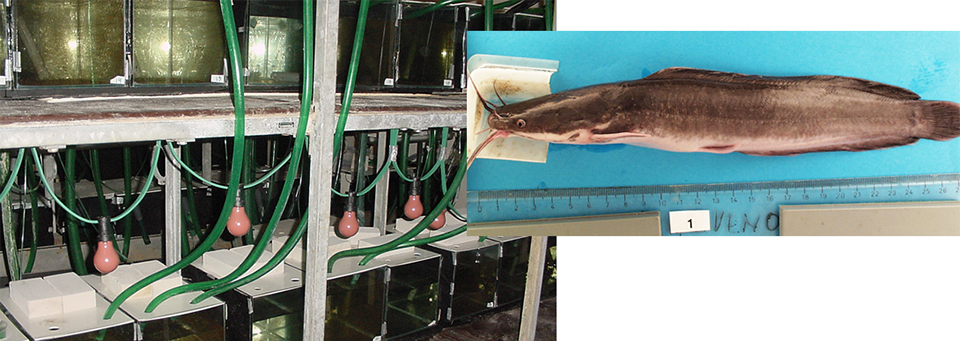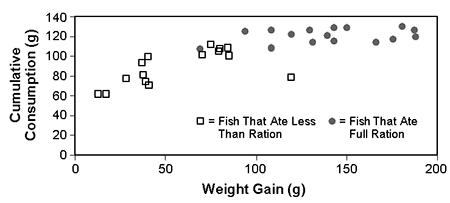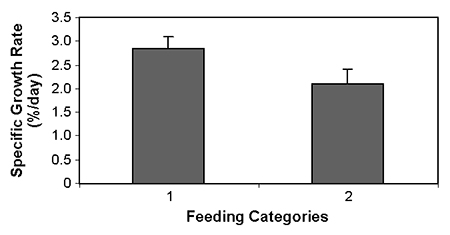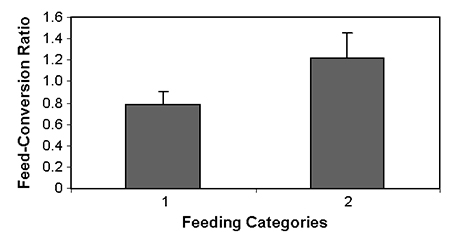Experiments eliminated social interactions to enable a proper analysis of the interactions between individual feeding behavior, feed intake and growth performance

In practical farm operations, fish often display a high growth variation among individuals, forcing farmers either to grade regularly or sell different and suboptimal sizes at harvesting. The background of this variation in growth is not well understood. Do fish grow differently because of individual variations in growth efficiency or differences in feeding behavior, or because of social hierarchies that affect the feeding behavior in tanks or cages?
Social behavior and growth
Often, the large growth variation is related to individual competition in a tank. Socially subordinate individuals are characterized by a suppressed aggressive behavior, reduced feeding, and low spontaneous locomotion activity, while dominant fish exhibit the opposite behavior.
Socially dominant individuals may have higher growth efficiencies and more appetite (Øverli et al., 2002). Therefore, Hecht and Appelbaum (1988) inferred that selecting for fast growth would indirectly mean selection for dominant and possibly cannibalistic fish in species which exhibit cannibalism.
This statement is based on the assumption that differences in social behavior are genetically determined. It also suggests that growth variation can only be reduced by genetic breeding. The question, then, is whether social behavior or other factors, such as feeding behavior or differences in growth efficiency, determine individual growth variation.
The authors recently designed a study at Wageningen University designed to get base-line information about interindividual variations in growth efficiency, food consumption, and feeding behavior in fish, and their possible relationships and application.
Study design
It is often assumed that differences in weight lead to differences in social hierarchies, and thereby cause differences in feed intake when fish are kept in groups. However, differences in feeding behavior may be a cause rather than a consequence for the differences in growth. Therefore, a series of experiments were designed in which social interactions were eliminated by individual housing to enable a proper analysis of the interactions between individual feeding behavior, feed intake, and growth performance.
The African catfish, (Clarias gariepinus), was chosen as a model fish. In general, catfish show a substantial interindividual variation in growth efficiency and are highly competitive when reared in groups. In addition, catfish species belonging to the genus Clarias have a proven commercial aquaculture interest in Asia, Europe, and Africa.
Study setup
Thirty-one fish of 65 ± 6 grams from a single spawn and with identical housing and nutritional histories were obtained from a local fish producer. These fish were housed individually for 42 days in 40-liter glass aquariums connected to a recirculation system. Water quality parameters were kept in the proper range for this species.
Animals were fed an experimental diet once a day by hand at a feeding level of 15 g.kg-0.8.d-1. This level was chosen to guarantee that all animals would receive the same amount of food. However, this was not realized because the fish refused different amounts of food at different time points. The final result was that 15 fish ate less than their ration, and 16 fish ate the full ration.
Total feeding time and feeding category were measured daily for each individual fish. Feeding categories were based on the fishes’ reactivity toward the feed pellets. After one week of observation, four feeding categories were defined:
- fish that immediately reacted to and continuously ate the food
- fish that reacted immediately to food, but did not continuously eat it all
- fish that reacted immediately to food, but tasted it, then spit it out, and finally ingested it
- fish that did not react immediately to food.
Specific growth, FCR, feeding time

A large individual variation in specific growth rate and feed-conversion – growth rates ranged 0.46-3.24 percent per day, while FCRs ranged 0.63-4.72. Based on the relation between feed consumption and growth (Fig. 1), there was a clear, large variation in the efficiency of growth between fish.
The interindividual variation in growth efficiency was most pronounced in the fish that ate all the feed they received. In this group, the total feed consumption was on average 120.6 g for the whole experimental period, with a coefficient of variance of 6.1 percent. Despite this relatively constant feed intake, there were large differences in growth that ranged 100-180 g, with a mean value of 139.7 g and coefficient of variance of 24.9 percent.
Total feeding time appeared to be strongly correlated with specific growth rate, indicating that the fast eaters were fast growers, or vice-versa. The fast-growing fish were also the fish that reacted immediately to the food by showing a frenzied behavior, such as those from category 1.
Growth efficiency And feeding behavior

The relationship between growth efficiency and feeding behavior can be easily understood when comparing fish that ate full rations and therefore had no or minor differences in cumulative consumption over the growth period (Fig. 2). All fish that did not have feed refusals belonged to feeding categories 1 and 2.
Although there were no differences in their cumulative feed consumption, specific growth rate and FCR were significantly different between the fast (category 1) and slow eaters (category 2). This indicated that feeding behavior has a relation with growth and/or feed efficiency.
Conclusion
Differences in fish feeding behavior can be a cause for differences in growth rather than a consequence of differences in body weight. In this, the first study to relate eating time and feeding behavior with growth efficiency, the fast-growing fish seemed to be the fast-eating fish. Fish that ate their complete meal in a few seconds grew faster than fish that ate the same amount of food over a longer period. This suggested that total feeding time is an important factor that affects the way fish utilize food.

Feed intake and growth have a genetic basis in fish. Based on the study, it can be hypothesized that in African catfish, fast eaters would be good candidates in genetic selection programs for growth performance. However, the consistency of the feeding categories and growth performance, together with the stress susceptibility of these fast eaters/fast growers, should be studied before any attempt to develop a selection program based on feeding behavior.
Note: Cited references are available from the authors.
(Editor’s Note: This article was originally published in the December 2003 print edition of the Global Aquaculture Advocate.)
Now that you've finished reading the article ...
… we hope you’ll consider supporting our mission to document the evolution of the global aquaculture industry and share our vast network of contributors’ expansive knowledge every week.
By becoming a Global Seafood Alliance member, you’re ensuring that all of the pre-competitive work we do through member benefits, resources and events can continue. Individual membership costs just $50 a year. GSA individual and corporate members receive complimentary access to a series of GOAL virtual events beginning in April. Join now.
Not a GSA member? Join us.
Authors
-
C.I.M. Martins
Fish Culture and Fisheries Group
Wageningen University
P.O. Box 338
6700 AH, Wageningen
The Netherlands[108,110,46,114,117,119,64,115,110,105,116,114,97,109,46,97,110,105,114,97,116,97,99]
-
J.W. Schrama
Fish Culture and Fisheries Group
Wageningen University
P.O. Box 338
6700 AH, Wageningen
The Netherlands -
J.A.J. Verreth
Fish Culture and Fisheries Group
Wageningen University
P.O. Box 338
6700 AH, Wageningen
The Netherlands
Related Posts

Health & Welfare
Low volume, high density: Milkfish demonstration project
A demonstration conducted at a milkfish farm in southern Philippines by the United States Soybean Export Council Soy-In-Aquaculture program highlighted the use of extruded floating feeds with satiation feeding management and principles of low-volume, high-density cage production.

Aquafeeds
Varied feed additives improve gut, animal health
There is increasing evidence that natural feed additives can have beneficial effects on aquaculture animals by supporting well-balanced gut microflora and improving gut health.

Innovation & Investment
Pilot recirculation system supports lobster-farming development in Norway
An intensive-culture recirculation system for farming European lobsters has been developed, with a pilot installation in Norway.

Innovation & Investment
Acoustic control improves feeding productivity at shrimp farms
In systems recently developed for shrimp farms, passive acoustic-based technology enables sensor-based control of multiple automatic feeders. Improved growth and feed conversion have been recorded at commercial farms using the technology.


